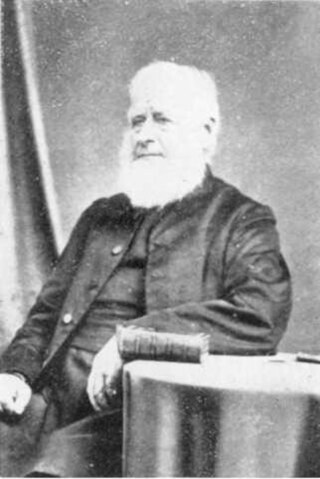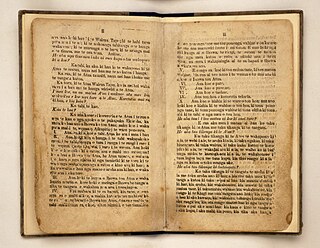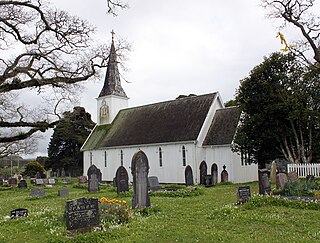
William Colenso FRS was a Cornish Christian missionary to New Zealand, and also a printer, botanist, explorer and politician. He attended the signing of the Treaty of Waitangi and later wrote an account of the events at Waitangi.

Henry Williams was the leader of the Church Missionary Society (CMS) mission in New Zealand in the first half of the 19th century.

Octavius Hadfield was Archdeacon of Kāpiti, Bishop of Wellington from 1870 to 1893 and Primate of New Zealand from 1890 to 1893. He was a member of the Church Missionary Society (CMS) for thirty years. He was recognised as an authority on Māori customs and language. His views on Māori rights, expressed in several books strongly criticised the actions of the New Zealand Government. Hadfield married Catherine (Kate) Williams a daughter of the Rev. Henry Williams and Marianne Williams.

William Gilbert Puckey, born in Penryn, England, was a missionary in New Zealand. He accompanied his parents to New Zealand at the age of 14. He became widely regarded as one of the best interpreters of Māori in the fledgling mission. He was able to form relationships of trust with many influential Māori from a young age, and in particular, with Nōpera Panakareao, of Te Rarawa iwi at Kaitaia.

Alfred Nesbit Brown was a member of the Church Missionary Society (CMS) and one of a number of missionaries who travelled to New Zealand in the early 19th century to bring Christianity to the Māori people.

Waimate North is a small settlement in Northland, New Zealand. It is situated between Kerikeri and Lake Ōmāpere, west of the Bay of Islands.

William Leonard Williams (1829–1916) was an Anglican bishop of Waiapu. He was regarded as an eminent scholar of the Māori language. His father, William Williams, was the first Bishop of Waiapu, Williams was the third bishop, and his son, Herbert Williams, was the sixth bishop of Waiapu.

William Williams was consecrated as the first Anglican Bishop of Waiapu, New Zealand, on 3 April 1859 by the General Synod at Wellington. His son, Leonard Williams became the third Bishop of Waiapu and his grandson, Herbert Williams, the sixth. His brother, the Rev. Henry Williams, led the Church Missionary Society (CMS) mission in New Zealand. William Williams led the CMS missionaries in translating the Bible into Māori and published an early dictionary and grammar of the Māori language.

Jane Williams was a pioneering educator in New Zealand. Together with her sister-in-law Marianne Williams, she established schools for Māori children and adults. She also educated the children of the Church Missionary Society in the Bay of Islands, New Zealand.
Bible translations into Oceanic languages have a relatively closely related and recent history.
Nōpera Panakareao was a New Zealand tribal leader, evangelist and assessor. Of Māori descent, he identified with the Te Rarawa iwi.

William Yate was one of the earliest New Zealand missionaries and writers who worked for the Church Mission Society. He was born in Bridgnorth, Shropshire, England in 1802. He joined the Church Missionary Society (CMS) and entered the Church Missionary Society College, Islington, London, in 1825. He was ordained as a deacon of the Church of England on 18 December 1825, and priest on 21 May 1826. Yate learned the Māori language and had Christian texts printed in Sydney for his work.

Rota Waitoa was a New Zealand Anglican clergyman, of Māori descent. Waitoa identified with the Ngāti Raukawa iwi. He was born in Waitoa, Waikato, New Zealand. Waitoa's ordination as deacon at St Paul's, Auckland, on 22 May 1853, was the first ordination of a Māori into the Anglican church.
John Morgan was an Anglican missionary and a member of the Church Missionary Society (CMS) mission in New Zealand in the 19th century. He was an important missionary to the Māori who established the Te Awamutu district.

Robert Maunsell was a New Zealand missionary, linguist and translator. He was born in Milford, near Limerick, Ireland on 24 October 1810.
George Clarke was a New Zealand missionary, teacher, public servant, politician and judge. He was born in Wymondham, Norfolk, England on 27 January 1798. He joined the Church Missionary Society (CMS). Clarke married Martha Elizabeth Blomfield. the second daughter of Ezekiel Blomfield, a Congregational minister.

Samuel Williams was a New Zealand missionary, educationalist, farmer and pastoralist.
The New Zealand Church Missionary Society (NZCMS) is a mission society working within the Anglican Communion and Protestant, Evangelical Anglicanism. The parent organisation was founded in England in 1799. The Church Missionary Society (CMS) sent missionaries to settle in New Zealand. The Rev. Samuel Marsden, the Society's Agent and the Senior Chaplain to the New South Wales government, officiated at its first service on Christmas Day in 1814, at Oihi Bay in the Bay of Islands, New Zealand.
James Shepherd (1796–1882) was an Australian-born Wesleyan Christian missionary and settler in Northland, New Zealand. He was prominent in the early European community of the Bay of Islands, involved in construction of the Stone Store in Kerikeri, and involved in drafting of the first written Maori publications.

St John the Baptist Church is an heritage-listed Anglican Church and associated churchyard built in 1831 by the Church Missionary Society (CMS) at Te Waimate mission at Waimate North, inland from the Bay of Islands, in New Zealand.
















